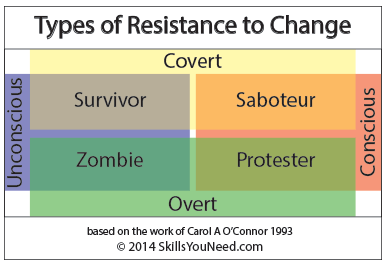Managing Resistance to Change
Part of: Change ManagementIn any change process, there will be a certain amount of resistance. Most of us, if we’re honest, would admit that we can be creatures of habit, and take a certain amount of time to get used to the idea of change. Some of us take that a little bit further, whether consciously or not.
If you’re managing a process of change, whether at home or in a work situation, it pays to be aware of how resistance can manifest itself in you and others, and have the strategies and skills to hand to help you overcome it.
Understanding Resistance to Change
Resistance to change can be either individual or organisational. Individual resistance comes from the people who are affected by the change and often arises from fear of the unknown or concerns about loss of status or perceived lack of skills to manage in the changed situation.
Based on whether or not people are aware of their actions (conscious or unconscious) and whether they are acting openly or not (covert and overt), we can define four types of resistance to change:

The survivor is intent on ignoring the process of change, and may even be hurt at the suggestion of non-cooperation.
The saboteur knows what they’re doing, but doesn’t want others to know. They may be motivated by the need to minimise their own losses. They’re unlikely to infect others directly, because they’re not being open about what they’re doing, but their behaviour may influence others.
The zombie lacks the will to carry out change, and is always likely to revert to their original behaviour.
The protester, like the saboteur, knows exactly what they’re doing but is much louder about it, making this the easiest type of resistance to spot. This is also the resistance most likely to spread to others.
Organisational resistance can arise from a mismatch between organisational mission, objectives, or culture and the change plan, or from lack of resources to implement change, or even from nostalgia for ‘the way things were’.
It can also result from individual resistance among senior people within the organisation who use their organisational power to block change.
Barriers to Problem Solving and Change
Problem solving is an essential part of making change happen, but there are various possible blocks or barriers which may hinder it and therefore the change process.
These blocks may include:
- Perceptual Blocks
Associated with the inability to identify problems, such as stereotyping, failing to see the situation from other perspectives, information overload, or looking at the problem from too narrow a viewpoint. - Emotional Blocks
These include fear of taking risks, intolerance of ambiguity, saying ‘no’ too soon, and not giving ideas time to mature. - Cultural Blocks
Such blocks include taboo subjects, taking things too seriously, failing to harness creative energy, and over-focusing on logic, or relying too heavily on tradition; - Environmental Blocks
Including lack of support, rejection of criticism, or inability to listen to others. - Mental Blocks
These blocks refer to the individual thought processes and inappropriate use of concepts or analysis, which can include using incorrect language, inflexibility and lack of correct information.
For more about problem-solving, see our pages on Problem-Solving Skills.
Overcoming Resistance to Change
One very useful tool for identifying how to overcome resistance to change is force field analysis.
This tool both analyses the situation, and gives a structured way of looking at how to overcome the most important resistors.
Force Field Analysis
Steps to success
Define the current change problem as accurately as possible, including strengths and weaknesses and the ideal situation.
List all the ‘helping’ and ‘resisting’ forces. These may be related to people, the economic situation, time, resources, the external environment or the organisation's culture, or indeed other issues.
Rank in order of strength of influence. You could either use a scale from 1–10, for example, or opt for a simpler classification of Strong, Medium or Weak, but do make sure that you think about them in relative terms.
Draw a force field diagram, with helping forces on one side and resisting ones on the other. For each force, draw an arrow whose length or thickness indicates its strength. Then decide whether each one is important, very important or not important.

Analyse each force. For each one labelled as either important or very important, see how it could be either strengthened (for a helping force) or weakened (for a resisting one).
Discuss your findings with others and agree a course of action that seems most likely to result in the desired change, including identifying resources.
Finally, draw up an action plan. For more information, see our page, Action Planning.
Strategies for Overcoming Resistance to Change
Once you have analysed your resisting forces, it is generally agreed that there are six possible strategies for overcoming resistance to change.
Education and Communication
This includes explanations of why changes need to take place and frequent communication to ensure that everybody is fully aware of plans.
It is useful where there has been inadequate information or analysis as it will help to persuade people of the need for change. However, it can be very time-consuming.
For help with this strategy, see our pages on Communication Skills, and in particular Effective Speaking, and Persuasion and Influencing Skills.
Participation and Involvement
This consists of the active involvement of everybody involved in the change, in as many of the processes as possible, supported by regular feedback.
Participation tends to lead to better commitment, and is particularly useful where leaders do not have all the information they need to design the change. However, it needs careful handling to ensure all changes are consistent with the overall vision or strategy.
For more help, see our pages on Strategic Thinking, Working in Groups, and Giving and Receiving Feedback. You may also want to look at Delegation Skills to understand more about involvement.
Facilitation and Support
This strategy involves providing positive support for people in new situations to allow them to fulfil their roles or job requirements.
This may include counselling and training, which can be quite expensive, and may not necessarily have the desired results. You may need to draft in outside help to achieve this strategy, as this kind of support is often best provided by neutral outsiders. This strategy may be best in combination with at least one other.
See our pages What is Counselling?, Motivating Others, Providing a Motivational Environment and Facilitation Skills for some further ideas.
Negotiation and Agreement
This strategy involves reaching realistic and acceptable agreements by listening to and analysing all the various points, both positive and negative, raised by people affected by the changes.
Use where resistance is coming from a particular, clearly-identifiable group which stands to lose from the change, but be aware that it can be expensive if used a lot!
For more, see our pages on Negotiation Skills.
Manipulation and Invitation/Co-opting
This strategy involves using the powers available to ensure that everybody involved has their say.
For example, in a work situations, invite staff to join focus groups that increase awareness of the current situation, which will increase morale and reduce resistance. This strategy is also sometimes used in a less positive way: to implicate the leaders of resistance in the change and undermine their position, which tends to lead to loss of your own credibility in the longer term.
See our pages on Ethical Leadership and Transactional Analysis to explore the negative implications of this idea further.
Explicit and Implicit Coercion
This strategy should be used as a last resort only, because it can reduce morale and the self-worth of the individuals involved or effected by the change processes.
While it can overcome resistance, the cost could be too great for the organisation or individuals and, if time allows, using negotiation is a better approach.
See our page on Transactional Analysis to explore the consequences.
Further Reading from Skills You Need
The Skills You Need Guide to Leadership eBooks
Learn more about the skills you need to be an effective leader.
Our eBooks are ideal for new and experienced leaders and are full of easy-to-follow practical information to help you to develop your leadership skills.
A Final Thought…
It is rare, if not unheard-of, for any major change process to meet with no resistance.
Most of us will have concerns about whether we’ll be able to cope in the changed world, or about potential loss of status, and these concerns often manifest themselves as resistance to change.
For anyone managing a change, whether personal or organisational, the challenge is to identify the resistance and find positive ways to overcome it.


